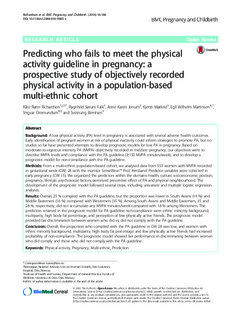Predicting who fails to meet the physical activity guideline in pregnancy: a prospective study of objectively recorded physical activity in a population-based multi-ethnic cohort
Richardsen, Kåre Rønn; Falk, Ragnhild Sørum; Jenum, Anne Karen; Mørkrid, Kjersti; Martinsen, Egil Wilhelm; Ommundsen, Yngvar; Berntsen, Sveinung
Peer reviewed, Journal article
Permanent lenke
http://hdl.handle.net/11250/2507770Utgivelsesdato
2016Metadata
Vis full innførselSamlinger
- Artikler [5061]
- Publikasjoner fra CRIStin FHI [7536]
Sammendrag
Background: A low physical activity (PA) level in pregnancy is associated with several adverse health outcomes. Early identification of pregnant women at risk of physical inactivity could inform strategies to promote PA, but no studies so far have presented attempts to develop prognostic models for low PA in pregnancy. Based on moderate-to-vigorous intensity PA (MVPA) objectively recorded in mid/late pregnancy, our objectives were to describe MVPA levels and compliance with the PA guideline (≥150 MVPA minutes/week), and to develop a prognostic model for non-compliance with the PA guideline. Methods: From a multi-ethnic population-based cohort, we analysed data from 555 women with MVPA recorded in gestational week (GW) 28 with the monitor SenseWear™ Pro3 Armband. Predictor variables were collected in early pregnancy (GW 15). We organized the predictors within the domains health, culture, socioeconomic position, pregnancy, lifestyle, psychosocial factors, perceived preventive effect of PA and physical neighbourhood. The development of the prognostic model followed several steps, including univariate and multiple logistic regression analyses. Results: Overall, 25 % complied with the PA guideline, but the proportion was lower in South Asians (14 %) and Middle Easterners (16 %) compared with Westerners (35 %). Among South Asians and Middle Easterners, 35 and 28 %, respectively, did not accumulate any MVPA minutes/week compared with 18 % among Westerners. The predictors retained in the prognostic model for PA guideline non-compliance were ethnic minority background, multiparity, high body fat percentage, and perception of few physically active friends. The prognostic model provided fair discrimination between women who did vs. did not comply with the PA guideline. Conclusion: Overall, the proportion who complied with the PA guideline in GW 28 was low, and women with ethnic minority background, multiparity, high body fat percentage and few physically active friends had increased probability of non-compliance. The prognostic model showed fair performance in discriminating between women who did comply and those who did not comply with the PA guideline.
